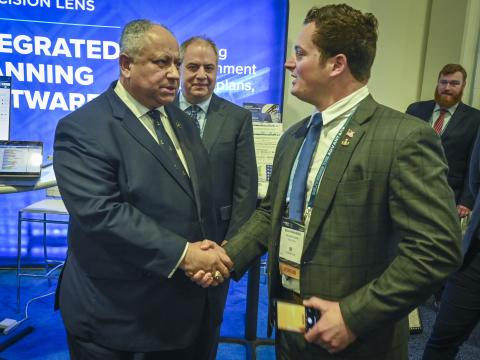The Len Sullivan Rules
There has been considerable discussion lately about using commercial technology more extensively in military systems, and encouraging commercial firms that have been very successful developing innovative technologies for the civilian marketplace to enter the defense marketplace. These are admirable aspirations that have been suggested in the past. But the effort recalls for me a very interesting discussion I was part of back in 1992 in—of all places—Moscow.
In 1992, I was enjoying an Army War College Fellowship at the Atlantic Council and part of a council delegation that was invited to Russia and Ukraine to discuss future directions in a range of policies with what we then called the “former Soviet states.” It was an impressive delegation that included, among others, Gen. Andrew Goodpaster, USA (Ret.), a former supreme allied commander Europe; Paul Nitze, a former Navy secretary; and Leonard Sullivan, a former assistant secretary of defense for program analysis and evaluation. During one session in Moscow, Nitze, Sullivan and I were meeting with a Russian official who had been given the job by the Boris Yeltsin government of converting the Soviet defense industry into a commercial industry.
Nitze, having been a successful investment banker, asked several questions about how this was to be accomplished, on what schedule and into what product lines. Our Russian host had few immediate answers as he was still, as he described it, in the process of fully determining the exact scale, scope and even locations of Soviet manufacturing facilities. I was stunned at his observation that it appeared, at the time, that the Soviet military industrial complex was so expansive that 70 percent of the overall industrial base supported the defense program in one form or another.
Sullivan had enormous experience in both government and the private sector. He had been a major force in matching innovative technologies with innovative operational concepts. Being disturbed at U.S. Air Force losses in attacks on fixed targets in North Vietnam, he had played a key role in the early development of precision guided weapons and airborne electronic warfare. He was, accordingly, no stranger to technological innovation and its application for military purposes. With this background, he offered our Russian host three reason why his efforts were almost certain to be frustrating and likely to be futile.
First, as Sullivan put it, was the enormous difference in market perception: “General Motors builds a car and hopes it can sell it; General Dynamics sells a jet and hopes it can build it.”
Second, was the massively different mix between the commercial and defense industries in personnel involved in research and design compared to those in production. In Sullivan’s view, “A commercial firm aspires to build a million things with a hundred parts; a defense firm aspires to build a hundred things with a million parts.”
Lastly was the enormously different customer relationships: “A commercial firm tries to meet the needs of thousands of customers with needs and tastes that change slowly and can be somewhat shaped; a defense firm tries to meet the requirements of a single customer with needs and tastes that can change quickly after the next election.”
Len Sullivan’s three rules, as I have come to call them, concisely and cleverly describe the major difference between commercial firms and defense firms, and they highlight the difficulty of getting a commercial activity to play a major role in the defense market. Essentially, commercial firms are quite different enterprises operating in very different ways with very different objectives and providing very different products. While there may be commercially developed components that can be incorporated into military systems—particularly in the world of electronics and software—the unique needs of military equipment limit the adaptation of commercial end items. Many of us in the Army deploying to Desert Storm in 1990 recall frantically swapping out a commercial truck (the CUCV) for Humvees, as the former did not have the necessary mobility for sandy desert terrain. Northrop Grumman CEO Wes Bush recently commented that although we have a tremendous commercial aircraft industry that has a clear interest in increased range and decreased fuel consumption, it has no interest in stealth. Military aircraft want to be invisible to radar; commercial aircraft want the opposite.
What does this mean? Any effort to benefit from a useful technology, regardless of its origin, should be considered for military use as it may offer reduced costs and simplified sustainment. But for the reasons Len Sullivan articulated in Moscow in 1992, the overlap between commercial products and military products is, for several reasons, small and unlikely to expand. These distinctions are a major reason why defense firms rarely have success in the commercial marketplace, and why commercial firms have little interest in defense. Moreover, these distinctions in structure and orientation are in addition to other barriers created by the government such as its limitation on profit, its intrusiveness into supply chains, its heavy regulatory demands and its high compliance costs.
Efforts such as those recently launched by Defense Secretary Ashton Carter and Deputy Secretary Robert Work in reaching out to innovative commercial firms, such as those in Silicon Valley, are certainly worth the effort. They are important in an era in which the nation’s defense industrial base is shrinking. But, such efforts should be understood as offering limited potential. They will be useful in supplementing the efforts of the traditional defense industry, but they are very unlikely to add greatly to it and certainly are not a substitute. As Len Sullivan pointed out: the distinctions between the two industries are great, and the similarities are small.
M. Thomas Davis is a former corporate vice president with General Dynamics Corporation and a past assistant professor of economics at West Point, the U.S. Military Academy.



